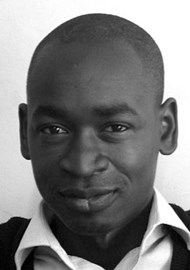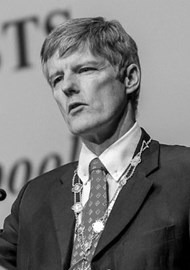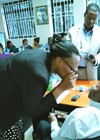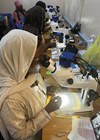As other articles in this series (IN FOCUS Apr 2020) demonstrate, the year 2020 is highly significant in the eye care field. Naming a global initiative ‘VISION 2020: The Right to Sight’ in 1999 was a daring way to focus minds on prevention and treatment of avoidable blindness in a defined timescale.
A public health approach was needed to address the huge number of people who had already lost their sight (45 million in 1995) and the many more millions who would go blind due to population increase, ageing and inadequate services over the next two decades unless urgent and decisive action was taken [1].
Other articles in this series summarise some of those international efforts and their results. This article summarises the efforts undertaken by the VISION 2020 LINKS Programme to address the huge human resource challenges required to facilitate the success of VISION 2020 – particularly focusing on sub-Saharan Africa (SSA), where, in most countries, there are only between one and three ophthalmologists per million population.
Background to the VISION 2020 LINKS Programme
The VISION 2020 LINKS Programme was established at the International Centre for Eye Health (ICEH), London School of Hygiene & Tropical Medicine, in 2004. Both ICEH and the WHO-led global initiative ‘VISION 2020: The Right to Sight’ recognised the key need for human resource development in Africa in order to reduce the ever-growing burden of unnecessary blindness. In the UK there had been many individual, short-term relationships with ophthalmologists going overseas to assist in both service-oriented and teaching capacities, but until then there had not been a systematic programme from the UK to partner Africa training centres to improve the quality and quantity of eye care training in Africa.
ICEH was approached by the Board of VISION 2020 UK, the national steering group for implementation of the VISION 2020 initiative, and invited to launch a programme that would harness the goodwill of UK ophthalmologists who were keen to offer their skills through short-term engagement, to address the need in Africa in a more systematic way. The VISION 2020 LINKS Programme was born, the LINKS Programme Manager, Marcia Zondervan, was appointed, and the first year’s funding was given by the eye care NGOs Sightsavers [2] and CBM [3]. The VISION 2020 LINKS Programme became an implementing project of the VISION 2020 global initiative.
The VISION 2020 LINKS Programme is designed to build long-term partnerships to increase the capacity of eye health workers in low- and middle-income countries (LMICs) and give them the knowledge and skills to tackle their eye care priorities. This approach establishes sustainable partnerships between teaching institutions in LMICs and appropriate partner eye departments in the UK. It is recognised that through long-term partnership, trust and friendship develops, which in turn enhances the value of the training and increases the likelihood of reaching the specific goals.
In order to ensure that there is an appropriate ‘match’ between partners, the partner in Africa is asked to carry out a detailed ‘needs assessment’ using a standardised template. Based on the priority needs a potential UK partner is identified and whole eye care team visits between the potential LINK partner institutions are undertaken. The partnership is formalised by a Memorandum of Understanding signed by senior leadership of each institution, with an agreed joint initial three-year Activity Plan setting out how the eye care teams will work together and what they aim to achieve. Attention is given to local and national eye care plans and strategies, and the National Eye Care Coordinator and Ministry of Health (MoH) are involved in planning the LINK. The Activity Plan forms the basis of a funding proposal to cover the costs of LINK training visits (usually in the region of £10,000 per year per LINK).
With an increasing realisation that the needs of LMICs for eye care can only be met by increasing the skills and capacity of ‘home-grown’ eye surgeons, nurses and other eye health workers, many UK institutions have recognised that they can make a contribution towards this. The list of VISION 2020 LINKS that have been established is shown in Table 1.

VISION 2020 LINKS in 2020
No two VISION 2020 LINKS are the same; each partnership develops according to the needs of the LMIC partner and the priority needs change over time. Hence the achievements of LINKS are many and varied and are related to the specific context in which each is working. Many have been described in previous articles in Eye News [4-7]. Funding has been obtained from a wide range of sources, some local and some national, to ensure the longevity of the LINKS. Benefits are mutual; UK participants value the time spent working with their partners in a resource-poor environment and the part that plays in their own personal and professional development.

Allen Foster facilitating a research mentorship workshop in Tanzania.
COECSA-RCOphth LINK
One of the longstanding and highly productive LINKS is that between the College of Ophthalmology of Eastern, Central and Southern Africa (COECSA) and the Royal College of Ophthalmologists (RCOphth). The LINK was established in 2008 and began by training examiners from all over Eastern Africa to deliver the COECSA Fellowship examination. The number of trainee ophthalmologists choosing to take the exam has grown steadily over the years; each year they are drawn from many different countries in the region [8].

COECSA Fellowship examination candidates and examiners in Malawi in 2014.
The LINK has expanded in a number of ways since its inception. For five years the RCOphth has been offering ‘train the trainers’ courses, similar to those run in the UK, to senior ophthalmologists across the region [9]. More recently, a programme of research mentorship training has been underway. With the help of funding from organisations including Tropical Health & Education Trust (THET), Queen Elizabeth Diamond Jubilee Trust and the British Council for Prevention of Blindness [10-12], the quality and breadth of COECSA activities has expanded thanks to the commitment of its partner the RCOphth. Through the close ties between the Colleges, the quality of ophthalmology training has been enhanced, improving the quality of eye care provision in the region.

Training the eye care team to use a fundus camera, Zambia.
LINKS and Networks
As a result of the strong, trusting LINK partnerships, further opportunities for enhancing the skills and capacity of eye health workers in LMICs have been made possible over the years since 2004. In 2014, the LINKS Programme was part of the Commonwealth Eye Health Consortium that received five-year funding from the Queen Elizabeth Diamond Jubilee Trust for a wide range of training, capacity-building and research projects in Commonwealth LMICs [13].

Diagram to show the network of LINKS that make up DR-NET.
Networks of LINKS have been established to address specific subspecialist training needs – to date these are diabetic retinopathy (DR), retinoblastoma (Rb), eye health leadership, Train the Trainers and research mentorship. Like LINKS, these take a whole-team approach to training and in the case of DR this includes endocrinologists / diabetologists; for Rb it includes oncologists, pathologists and counsellors. Representatives from Ministries of Health in each country have been important participants in the DR and Rb networks to ensure that development of services is integrated into national plans.
Diabetic Retinopathy Network (DR-NET)
In 2014, 15 VISION 2020 LINK partnerships, all working on DR, came together as a network to share learning within and between countries in Africa, the Caribbean and the Pacific, through funding from the Queen Elizabeth Diamond Jubilee Trust [14,15].
Some key activities of DR-NET were:
- Initial situation analysis of all partner centres to establish baseline data
- International workshops bringing together whole eye care teams, including MoH representative
- Development of rolling two-year Action Plans to track progress towards specific goals
- DR-NET Toolkit developed – for planning and implementing DR services
- Whole-team training visits between LINKS partners to build capacity for DR services
- Development of national DR guidelines in collaboration with MoHs.
The challenge taken up by the participants in the initial DR-NET Workshop in 2014 was for each of the 15 centres to increase the number of people treated for DR by a minimum of one person per week for five years. With 15 participating centres, this would save an extra 3750 people from losing their sight, estimated as saving approximately 37,500 ‘years of blindness’.

Participants in the DR-NET Workshop held in London in March 2019.
Some key activities of DR-NET were:
- 92 training visits were undertaken between LINKS partners
- 81 screener-graders from 10 countries undertook an eight-month online training course to achieve an internationally-recognised standard
- Four international workshops were held (Heathrow 2014, Durban 2016, Addis 2018, London 2019) to review progress and share learning
- A laser training course was developed and rolled out in eight countries with 93 participants.
In addition, the initial 15 LINKS in DR-NET expanded to 22 over the five years 2014-2019.
Key outcomes of DR-NET were:
- National DR frameworks and guidelines were drawn up in Kenya, Tanzania, Uganda, Zambia and Botswana
- Stakeholder meetings have been held and preparation of guidelines is continuing in Malawi, Nigeria, Ghana and the Caribbean
- DR services expanded, or in some cases started, in 10 countries in Africa, the Caribbean and the Pacific
- The original goal of treating an EXTRA 3750 was exceeded by over 100% with an EXTRA 8063 patients receiving sight-saving treatment.

Visit of HRH The Countess of Wessex to Malawi in March 2017.
Retinoblastoma Network (Rb-NET)
Since 2004 a need repeatedly identified during LINKS training visits has been assistance in the management of Rb. In 2017, thanks to funding from the Queen Elizabeth Diamond Jubilee Trust, the VISION 2020 LINKS Programme developed a network to enable training and development of Rb services in sub-Saharan Africa [16].
Rb-NET began with seven institutions in Kenya, Tanzania and Uganda in partnership with five institutions that provide tertiary level Rb services (two in India, two in the UK and one in Israel). In the UK the number of Rb cases presenting late is thankfully very low, but centres in India see a higher proportion of cases with late presentation and therefore have relevant clinical experience to share with network partners, particularly those in Africa.
Multidisciplinary working is essential to save children’s lives and sight, so Rb-NET involved ophthalmologists, paediatricians, oncologists, pathologists, nurses and MoH representatives from each country. Like DR-NET, participating centres agreed to report to the LINKS Programme on monthly core indicators.
Over the two years of Rb-NET, training visits have taken place between centres to enhance the quality of treatment of Rb. Learning has included alternative ways of approaching treatment, such as chemo-reduction and transpupillary thermotherapy, which have since been implemented and brought improved results. Network partners have worked together on treatment guidelines to standardise protocols appropriate for resource-limited settings. Training input into pathology services has been key, as most SSA Rb centres rely on general pathologists for their histopathology reporting.
A further exciting development of Rb-NET was the enthusiasm of the centres for participating in research. As a result, our colleague Dr Didi Fabian led a Global Presentation Study, recording 4351 cases of Rb that presented in 278 Rb treatment centres in 153 countries in 2017. This has been published in JAMA Oncology [17]. By highlighting differences in presentation in countries of differing income levels, it is hoped that this will help in advocacy for increased funding to be directed to early detection and treatment of Rb.
Summary
The global call to action of the ‘VISION 2020: The Right to Sight’ initiative has led to international efforts to address the huge need to reduce avoidable blindness in LMICs. Through the LINKS Programme, hundreds of UK eye health workers are giving generously of their time and expertise to train and build the capacity of eye departments across more than 20 LMICs. Working alongside their counterparts and sharing expertise as colleagues and friends is proving a successful and mutually-beneficial way of building capacity to treat and prevent unnecessary loss of sight and blindness in LMICs.

Rb-NET participants reviewing Rb services at LV Prasad Eye Institute, India.
The LINKS Programme harnesses the goodwill of UK eye health workers but is dependent on fundraising to cover the cost of flights and accommodation for training visits – donors are constantly needed to ensure the success of the LINKS Programme.
The VISION 2020 LINKS are still needed in 2020 and beyond as much as ever. As the other articles on VISION 2020 in this issue show, there is still a dire shortage of eye health professionals in SSA and a huge unmet need for eye services. Changing lifestyles mean that Africa faces an epidemic of diabetes in the coming decades. Eye services have to evolve and expand to keep pace with the changing needs of the population. While the imbalance exists between the number of trained professionals and the population to be served, and as two-thirds of ophthalmologists are based in main cities and towns, whereas two-thirds of the population live in rural areas (18), there remain enormous challenges ahead to eliminate avoidable visual impairment worldwide.
References
1. Frick KD, Foster A. The magnitude and cost of global blindness: an increasing problem that can be alleviated. Am J Ophthalmol 2003;135(4):471-6.
2. Sightsavers:
https://www.sightsavers.org
3. CBM:
https://www.cbm.org
4. Walker C, Zondervan M, Astbury N. VISION 2020 Links Programme: building capacity in Eastern Africa. Eye News 2013;19(6):48-50.
5. Zondervan M, Walker C. Building Capacity for Children’s Eye Care in Africa: the VISION 2020 LINKS Programme. Eye News 2014;20(4):32-6.
6. Ellis J, Muhiddin H, Zondervan M. The invisible touch: a VISION 2020 LINK with Indonesia. Eye News 2014;20(5):24-8.
7. Martin S, Ceesay W, Sohna H, Zondervan M. The Gambia-Swansea VISION 2020 LINK: building eye care services and international friendships. Eye News 2014;21(1):26-30.
8. Costello D, Gachago M, Onyango J, et al. VISION 2020 LINKS: COECSA Fellowship examination goes from strength to strength. Eye News 2019;25(6):20-5.
9. Corbett M, Mathenge W, Zondervan M, Astbury N. Cascading training the trainers in ophthalmology across Eastern, Central and Southern Africa. Globalization and Health 2017;13(1).
10. THET:
https://www.thet.org
11. Queen Elizabeth Diamond Jubilee Trust:
https://www.jubileetribute.org
12. British Council for Prevention of Blindness:
http://www.bcpb.org
13. CEHC:
https://cehc.lshtm.ac.uk
14. Poore S, Foster A, Zondervan M, Mabey D, et al. Commonwealth nations join forces to prevent blindness from diabetes. Eye News 2015;21(5):33-6.
15. Astbury N, Burgess P, Foster A, et al. Tackling diabetic retinopathy globally through the VISION 2020 LINKS Diabetic Retinopathy Network. Eye News 2017;23(5):30-4.
16. Williams P, Bowman R, Foster A, et al. Rb-NET: a network to save life, preserve eye and vision in children in Africa. Eye News 2018;24(6):32-4.
17. Fabian ID, Amadou AB, Philbert R, et al. Global Retinoblastoma Presentation: Analysis by National Income Level. JAMA Oncology 2020; doi:10.1001/jamaoncol.2019.6716 [Epub ahead of print].
18. Palmer J, Chinanayi F, Gilbert A, et al. Mapping human resources for eye health in 21 countries of sub-Saharan Africa: current progress towards VISION 2020. Hum Resour Health 2014;12:44.
(All links last accessed February 2020)
COMMENTS ARE WELCOME












